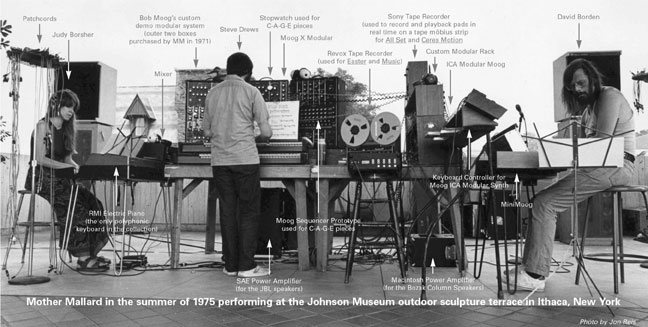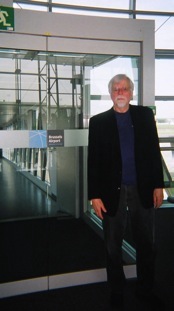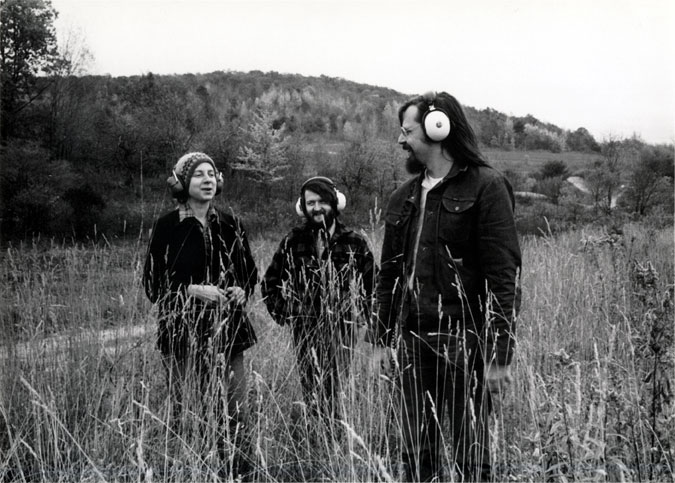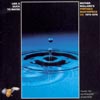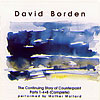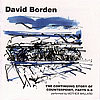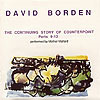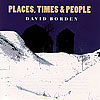40th Anniversary of MOTHER MALLARD: minimalist masters & electronic music pioneers. Two world premier performances of music by composer David Borden. Click For Infos.
|
The world’s first all-synthesizer ensemble, Mother Mallard’s Portable Masterpiece Co., celebrates its 40th Anniversary with two concerts at Cornell University, Ithaca, NY |
|
Mother Mallard’s Portable Masterpiece Co. will present its fortieth-anniversary concert featuring two world premier performances of music by composer David Borden. Sponsored in part by the Cornell Council for the Arts. Sunday, March 29, 2009, 8:00 p.m.
Composer: David Borden Keyboards: Blaise Bryski – David Yearsley Electric Guitar: Gabriel Borden Digital Video: Franck Vidal – Noni Korf Vidal FREE and open to the public AND May/June 2009 David Borden is one of America’s most accomplished classical minimalist/post-minimalist composers. His standing as a composer belongs besides that of such long-recognized masters of minimalism as Steve Reich, Philip Glass and Terry Riley,who are the same generation as Borden. Borden’s cyclic composition, “The Continuing Story of Counterpoint”, released on a series of three CD by Cuneiform, is a recognized masterpiece of the minimalist genre.
If you would like to request information on these or future concerts involving David Borden, please contact Rebecca Godin: rebeccagodin@mac.com. If you would like to request information on releases featuring David Borden/Mother Mallard on Cuneiform, please contact Joyce @ Cuneiform: joyce@cuneiformrecords.com.
The upcoming 40th anniversary concert will take place in Barnes Hall at 8:00 PM on Sunday evening March 29th. Three pieces will be given world premiers. The featured piece will be “Viola Farber in 7 Movements” with live video showing Farber’s dancing and choreography both as a soloist and with her company. In addition, a section from Borden’s “The Continuing Story of Counterpoint” that was composed in 1979 will receive its first performance. And finally, a piece honoring Jimmy Giuffre, the gifted jazz composer and clarinetist/saxophonist will be premiered. Giuffre was Borden’s first composition teacher. He died last April at the age of 87. MMPMC started as an ensemble that performed on three Modular Moogs, two MiniMoogs, and an RMI Electric Piano. Now MMPMC uses MIDI Controller keyboards attached to Apple computers via USB and an electric guitar. Bob Moog’s personal synthesizer demonstration unit that he traveled with in the late 1960s will be on display along with an early MiniMoog. These instruments and others were caught in a photograph by Jon Reis in 1975 while the band was performing at the Johnson Museum. The photo was blown up into a poster which will be present at the performance, and which appears at the top of this email. All music on the program was composed by David Borden. Mr. Borden taught at Cornell for 37 years. For the first 19 he was Composer/Pianist for Dance and for the last 18 he was founder and director of the Digital Music Program which is now called the Cornell Electroacoustic Music Center headed by Prof. Kevin Ernste. The new pieces that will be performed at this show are: “Remembering Jimmy” – “a piece in memory of Jimmy Giuffre who passed away last April. Jimmy was my first composition teacher and used to let me sit in on rehearsals of his Jimmy Giuffre Three groups. I got to know Jim Hall, Ralph Pena, and later, Bobby Brookmeyer. He was always extremely generous and gracious and encouraged my creativity.” – David Borden The other piece is ” Seven Movements for Viola Farber.” “This piece involves video projection that changes with each performance, and is intended as a companion piece for the tribute to Ruth St. Denis and Ted Shawn that we did in 2007. Viola was a star performer with the Merce Cunningham Dance Company for over a decade before she formed her own modern dance company in the late 1960s. As a keyboardist who earned his living by accompanying dance classes, I started accompanying her when she visited Cornell in the early 1970s. I instantly fell under her spell and volunteered to accompany her classes whenever I was in New York. Some of her dancers were also connected with Cornell: Willi Feuer and later, Jumay Chu. The video images for this piece are from DVDs and still photos sent to me by Jeff Slayton, her husband and biographer. In addition some of the moving images are from a film made for television entitled “Brazos River”, directed by Robert Rauschenberg courtesy of Anne Livet, President of Livet Reichard Company, Inc.” – David Borden
Mother Mallard’s Portable Masterpiece Company; David Borden, director. Mother Mallard celebrates its fortieth year with electroacoustic music by Borden, featuring keyboardists David Yearsley, Blaise Bryski and Josh Oxford, with live video projection by Noni and Franck Vidal, and some “blasts from the past.” Funded, in part, by a grant from the Cornell Council for the Arts. ******** “Within the minimalist ranks, David Borden’s music has always stood alone with its logic of motion, elegance of line and form, and deft use of state-of-the-art technology… Borden writes a complex and hyperactive form of counterpoint, often through-composing each line as a separate entity yet interlocking them in synchronous orbits. He winds his pieces up like gyroscopes and sends them spinning full-tilt from the start.” – John Diliberto, Audio (USA) ************ Band Biography:
The first incarnation of the ensemble was called Mother Mallard’s Portable Masterpiece Company, and performed pieces by several young composers of that era including Terry Riley, Robert Ashley, Steve Reich and Philip Glass. By 1971 MM was performing only the music of its three composer-performers Steve Drews, Linda Fisher and David Borden. In 1973 the group released it’s first LP recording on its own label, Earthquack Records. It was enthusiastically received by critics. In 1975 Judy Borsher replaced Linda Fisher, and another LP followed (Like a Duck to Water) which was also a critical success. The ensemble found itself with a cult-like following and performed at most of the avant-garde venues in New York City. In 1977 Chip Smith replaced Steve Drews, and continued under the exclusive direction of David Borden. The group has been disbanded and reformed several times since 1978. Along the way MM has performed in New York at the Kitchen, the Knitting Factory, the WBAI Free Music Store, The Alternative Museum, Danceteria, Town Hall and Lincoln Center. In Europe MM has performed at the Barbican Center in London, the Portsmouth Festival and The Tivoli Koncertsalen in Copenhagen, Denmark in addition to many universities and festivals in the United States and Canada. In January there will be a retrospective CD released on the Cuneiform Label featuring many of the original recordings and some previously unreleased material. Currently there are four CDs available of MM on Cuneiform, including the entire Continuing Story of Counterpoint cycle as well as some of the Birthday Variations. In addition to the Mother Mallard titles, Cuneiform released a David Borden compilation, titled Places, Times and People. David Borden was the Director of the Digital Music Program at Cornell University where he has been teaching since 1968. Before coming to the Music Department in 1987 he was Composer-Pianist for Dance in the Department of Women’s Physical Education (now defunct) and the Department of Athletics. He earned his undergraduate degree at the Eastman School of Music and holds Masters Degrees in Music from both Eastman and Harvard University. He first came to Ithaca in 1966 on a Ford Foundation Grant as Composer-in-Residence for the Ithaca City School District. Before that, he attended the Hochschule für Musik in Berlin, Germany as a Fulbright student. His teachers have been many: Leon Kirchner, Gunther Schuller, Howard Hanson, Bernard Rogers, Wolfgang Fortner, Boris Blacher and Aaron Copeland. His first composition teachers were jazz musicians: Jimmy Giuffre and Jaki Byard whose influences can still be heard in his music. His music has been performed the world over. Mother Mallard / David Borden albums: “Of the minimalist school, David Borden is probably one of the most undeservedly obscure. The founder of Mother Mallard Portable Masterpiec Co., Borden has been quietly releasing a series of astounding records since the early ‘70s that incorporate his love of pre-Renaissance liturgical music, synthesizers (both analog and digital) and what he’s learned from LaMonte Young.” – Reflex
1970-73 Listen: 1970-73 collects the first album by Mother Mallard’s Portable Masterpiece Co. and previously unreleased recordings. MMPMC were also one of the very first [possibly the first] performing synthesizer ensembles, working closely with Robert Moog, whose first factory was nearby. This material pre-dates or is contemporary with the first contributions to the genre and had been forgotten until now. With Steve Drews & Linda Fisher. Press quotes: “….this music has a timeless quality. 3 1/2 stars” “..in the letter “M” of the ”Records which Changed My Life”…we now have the original Mother Mallard silvered…This was minimalism before it became mechanical or intellectual; soaring flights of fancy within a loosely-held structure. Pieces like “Cloudscape for Peggy” or “Train” are tone poems; these are precursors of what later became the scourge of “ambient” (read “new age”…) music. Slowly developing and evolving, these retain the human touch…Mother Mallard is a must-get for anyone interested in any genre of music…If your tastes tend toward electronic, drone, trance, free jazz, even to composers of such disparate sonorities as Olivier Messiaen and Arvo Pärt, you must buy this disc. You must. That’s all.” “The sound is largely ambient – school of Riley, Glass, etc – featuring mini-Moog drones and subtly shifting textures, but one track percolates nicely around a sampled loop… this was 1972. Fascinating stuff.” “The same year, Wendy Carlos was acquiring fame with Switched-On-Bach, Mother Mallard’s Portable Masterpiece Company was turning their talents towards more minimalist music styles.. the music is comparable with the best minimalist music composed of the day…This album is truly a historic journey of the original pioneers during the early days of synthesizer music.” “Cuneiform has just released the early works of Mother Mallard… and it’s eye-opening in terms of innovation, providing the missing links between several disjunctive musical styles. They took textbook minimalism and added a rock beat to it; they created ethereal synthesizer landscapes, the worst aspects of which would molt into new age, the best of which would emerge as playful, intellectual electronica by Ryoji Ikeda or Aphex Twin…Each of the five tracks here provides some sort of Rosetta stone in terms of figuring out how several styles of music evolved in the way that they did. The first cut, “Ceres Motion” (1973) shows the transition between pulse-based high minimalism and full-blown prog rock; its the missing link between the loopy keyboards of Terry Riley or Philip Glass and the baroque precision of Tangerine Dream or early Yes….It’s just another reason to be thrilled that Cuneiform brought these essential, long-lost works to light.” “… Mother Mallard… have their place in history. But is the music any good? You bet. This disc is pretty much essential for collectors of electronic music, as well as anyone interested in its origins…. 4 stars” “…unlike other early electronic contemporaries, very little here sounds dated. Indeed, its amazing how fresh much of this music sounds… perhaps now Mother Mallard will get the recognition they clearly deserved.” “Calm, slow beautiful music played on those huge modular Moogs that need a million patch cords to make one sound.–the kind Wendy Carlos used to make “Switched On Bach.” “Cloudscape” perfectly evokes such a thing; so does “Train” and the slower moments of the others, but when they get kicking, it’s reminiscent of other pulse-music made at the time by Riley, Reich & Glass, and most worthy of that company. “Easter” bops and gurgles in a most Kraftwerk-like fashion, foreshadowing the “Krautwerk” that was to come.” “… big modular Moog synths, beefy chunky electronics in dazzingly complex arrays, ably turned out by three dextrous musicians.” “Most of the music here is beyond minimalism; in fact, it’s much closer to exploratory proto-space music or new age on the highlights “Ceres Motion and “Cloudscape for Peggy,” the latter of which was composed around the time acts like Tangerine Dream and Cluster were just getting started.” “The music on 1970-73 shows a range of styles, all of which are familiar in hindsight, but which Mother Mallard predated by several years. Eno’s ambient wallpaper, Glass’s minimalist manifestos, and the German clockwork calibrations are all evident in these compositions dating from an era when electronic music was still being met with confused stares. …To listen to Mother Mallard’s quiet experimentation today is to be reminded of the 25 years that followed their tentative but innovative footsteps. For fans of this brand of music, 1970-73 is a thrilling archival piece that gives a rare glimpse into the primal beginnings of a style of music that barely existed and was years away from acceptance when these recordings were made.” “We’re talking History here, folks!… The word “minimalism” hadn’t yet been coined, but Mother Mallard’s music would end up being one of the genre’s forerunners…this will sound as new as anything. …Mother Mallard’s was able to be quite UN-self-conscious, to be humorous in its compositions, and actually grooved and rocked a good deal on some of the pieces therein. …this is hugely recommended.” “Aside from being an invaluable historical document for any serious fan of ambient/electronic music, this is also a warmly enjoyable collection… With only four-track recording and patch cord tuning, Mother Mallard made incredibly alive electronic music.” “Mother Mallard was part of that world of flexible musical boundaries, able to borrow styles from both the Minimalists as well as from current psychedelic rock and jazz. Masterpiece contains five pieces which range from what we would now call “trance rock” to quiet, impressionistic “ambient”…” “Throughout the ‘70s, MMPMC pioneered the use of Moog’s keyboards, particularly in live performance settings.. Drones and complex rhythms mark their recordings, with multitrack layering borne out of his contrapuntal approach to composing. Critics missed the point as usual, complaining that “nothing happened”. Now, years later, the original Moogs are prized collector’s items and the analog synth is attracting newfound serious interest.” “Before many of these ravers and club-goers were even born, Mother Mallard’s Portable Masterpiece Co. induced such mind-calming therapy in its listeners through the sole use of Moog synthesizers….”1970-73” features only pure-Moo[g] compositions by the original trio of Linda Fisher, Steve Drews and David Borden. Moog enthusiasts should take note that “Music” on this collection is performed on the first MiniMoog ever made… The layers and repetitive interaction of two or three Moogs interacting on the twelve-minute-plus tracks here is a gateway to a comfortably cushioned analog sonic paradise.” “Sometimes a writer gets a release that… evokes such strong, pleasant memories of discoveries made in one’s youth… I was overjoyed to find this release…I have listened to this music since 1971, and bought their first LP at a 1974 live show at NYC’s “Public Access Synthesizer Studio” (PASS), which existed to serve as a non-profit performance Space for Electronic Music, and allow local composers, musicians, and artists the ability to utilize Electronic Music instruments economically… _
Like a Duck to Water Listen: Like A Duck To Water was Mother Mallard’s 2nd & final release, and was originally released in 1976. The music is a unique and extremely enjoyable blend of space electronics (ala Tangerine Dream, Klaus Schulze), minimal music (Terry Riley, Philip Glass), and contemporary classical & electronics (Gordon Mumma, John Cage). This album showcases a uniquely American slant on synthesizer music by a band whose pioneering contributions to the genre had been forgotten until now. Includes the original album, 20′ of previously unheard bonus material, and bonus CDRom material; a QuickTime video of the band in performance in 1976. With David Borden, Steve Drews & Judy Borsher. Press quotes: “…Mother Mallard’s Portable Masterpiece Co….played systemic, repetitive music, tonal avant-garde, and such-like-a different world from what we usually associate synthesizers with…The three album tracks each demonstrate a different facet of the Mallard’s sound. Steve Drews works are especially well-represented here. His Oleo Strut opens the album, sounding like an electronic harpsichords version of Terry Riley’s IN C, as patterns of notes weave in and out, gradually growing and changing…The other side of the original LP is David Borden’s C-A-G-E- Part II, based around a cycle of the notes C, A, G and E, naturally, a superbly hypnotic work that almost endlessly recycles itself for 20 minutes.…a nice historical document, showcasing a unique and important band.” “Mother Mallard was an electronic trio who prefigured not only the ‘90s electronica boom, but much of the synthesizer-based music of the ‘70s. They were purportedly the first American all-synth ensemble, and though they never achieved mainstream success, their level of importance in on a par with contemporaries like Tangerine Dream. Unlike T. Dream, Vangelis, or any other ‘70s electronic giants, Mother Mallard was more closely aligned with academia-oriented New Music types such as John Cage and Gordon Mumma than with the rock world, their music as represented here strikes a comfortable balance between the cerebral minimalism of Terry Riley and the accessible melodic approach of Klaus Schulze, Synergy, et al.” “…This disc is entirely the work of members David Borden and Steve Drews… Their pieces tend to be gently, swelling compositions that rise and fall like a great aural tide…This ambient experimentalism, including a piece based on ideas by John Cage, emerges from the early roots of American electronic head music. Their fascinating, organic minimalism is an important archive and effective music that combines the best of Terry Riley and early efforts from Phillip Glass and Tangerine Dream.” “…this overdue reissue of the 1976’s ‘Like A Duck To Water’ is most welcome…This is 1976, remember: Phil Glass is just settling down into the yawningly regular chord-sequences of his post-Einstein music, Steve Reich’s polishing the 6/4 surfaces of the ‘Music for 18 Musicians,’ and here’s Borden screwing it all up with irregular meters(fives, sevens, seventeens) and having a ball in the process. Fun stuff.” “Before German bands like Kraftwerk and Tangerine Dream brought electronics to center stage, the path had already been broken in the U.S. by Mother Mallard’s Portable Masterpiece Company…Like a Duck To Water is a CD re-release chronicling MMPMC’s work from 1974-76. Their music draws inspiration from Robert Ashley and Terry Riley’s explorations into minimalist repetition. The compositions are absolutely gorgeous, with layer upon layer of repeating rhythmic phrases that gently shift their flow with the purposeful effortlessness of a Zen meditation. “…the band was the first all-synthesizer ensemble, borrowing instruments directly from Robert Moog, to explore the hypnotic cadence of contrapuntal, minimalist music. Phillip Glass and Steve Reich are among the band’s contemporaries…the band members had an intimate, unspoken communication and understanding among them, using stopwatches, a primitive sequencer and intuition to time the intricate weaving of pitches and beats into these beguiling, icy works. What MMPC lacked in technological sophistication by today’s standards, it more than made up for in communal synergy; musical intelligence; and unreserved emotional expression.” “…most tracks being repeated rythyms with very slight melodies creeping in here and there-a sort of cross between Tangerine Dream and Phillip Glass…Glass and Steve Reich were doing similar things at about the same time…well worth hearing as a pioneering piece of musical history…” “This album is a trip back in time to the days when MIDI was just a weird dream and the demagnetizing of tape heads had to be done every half hour or so because the direct waveforms were asymmetric enough to kill their ability…A time when live really did mean live, and playing more than one note at a time meant having to have at least two synthesizers within easy reach. “This edition of MMPMC consisted of Steve Drews and Borden on the Moogs, Judy Borsher on the EMI Electric Piano. Borden’s ‘60s hippie demeanor might have deceived a few critics at the time, but he was very much the classicist, and his magnum opus, the 12-part Continuing Story of Counterpoint, was really inspired by Bach’s The Well Tempered Clavier. However, on two early Mother Mallard releases, the music is a little less schematic, and often quite trippy. The combination of subtle counterpoint variations and repetition can really mess with the listener’s time sense, and it achieves a lovely aural disorientation. This early work compares favorably with the recordings of better-known minimalists such as Terry Riley, Steve Reich and Phillip Glass, and it still retains its charm and hypnotic appeal.” “Albums like this one help the listener to understand the origins and the evolution of electronic music better than any book…Mother Mallard explore the beauty and the complexity of rhythmic sequences and those of other elements that shaped the identity marks of Space Sequencer Music, while at the same time adopting a structure typical of Minimalism, directly linking it all with the experiences that other pioneers were carrying out in the field of scholar musical experimentation.” – The Continuing Story of Counterpoint, 1-4 Listen: The Continuing Story Of Counterpoint is a remarkable 12 part musical cycle that Borden composed between 1976-87. Lasting 3 hours, Cuneiform has released this seminal work on 3 CDs, each containing 4 parts. The music is a pleasing and highly listenable mixture of classical forms, dense textures, strict counterpoint, and high energy electronics. AUDIO Magazine had this to say about the series: “When released in its entirety, this series may stand as the ‘Goldberg Variations’ of minimalism, a canon of work that defines a style and an era.” Press quotes: “the [Counterpoint] cycle is in the regal style of the small electric ensemble (keys, wind, guitar and voice… and placed Borden with the giants of the first wave of minimalist composers (Glass, Riley, and Reich). For those who appreciate this dizzying rapidly-repeating and hypnotic form of music, the release of this CD stands as a landmark in the field.” “David Borden is a minimalist composer, with medieval roots… The Continuing Story of Counterpoint is a set of elaborate contrapuntal melodies that sometimes rush by like Guillaume de Machaut on amphetamines, at others like a slow-motion aerial ballet. Borden’s interwoven lines unfold like Melvin Prueitt’ds computer design, Wing, twisting and turning in three dimensional space, each shift of the perspective revealing new facets. The relentless precision of his synthesizer arranged lines are balanced… by the pure soprano of Ellen Hargis. Intoning the names of contrapuntal composers and techniques, it makes this music sound like a 14th Century hymn sung in space. “With his ensenble, Borden practices a kind of minimalism that moves in the opposite direction of Philip Glass’. You could even call Borden’s style maximalist to describe the Phil Specter-like wall-of-sound produced by his kinetic, loopy melody lines. In fact, Borden’s music has less in common with modern minimalists, and a lot more with the kind of heavy counterpoint and contrapuntal tendencies found in Baroque music. Imagine an updating of the Back “Inventions” played by denizens from the New York downtown art scene.” “unlike the penchant other minimalists have for backloading some (often overwrought) emotional content into their essentially emotionless methods, Borden seems content to let the music’s pure structure carry it or fail on its own…with Borden’s orchestra, Mother Mallard, swimming happily in a midstream between “serious” and more popular musics – between Glass-Reich-Riley and, say, the brainier keyboard projects of pop intelligensia like Eno and Mark Mothersbaugh.” “Borden’s work has qualities similar to Glassworks-era Philip Glass and Terry Riley’s In C. The music has very quick repetitious themes that glide effortlessly, then collide into one another. Unlike Glass or Riley, who let their compositions slowly evolve, Borden triggers countermelodies so quickly that they appear sontaneous or improvised.” “David Borden’s The Continuing Story of Counterpoint series, in 12 parts…occupies three full Cds, and took Borden 11 years to complete. With a solid academic grounding in the work of early contrapuntal composers and the literature of counterpoint, Borden set out to, in his own words, “develop my own contrapuntal language.” The singlemindedness of Borden’s quest… allowed Borden to complete a truly impressive, even definitive, work of 20th century minimalism, which more than one critic has compared to Bach’s “Goldberg Variations.”…it’s important to keep the record straight and give Borden the credit he deserves…he is a true contemporary of Reich and Glass, rather than just a disciple… The music in Borden’s Counterpoint series.. has a relentless rythmic base and an abstract, almost mathematical precision… Like Bach, Borden is not a tunesmith who composes hummable melodies; he has more lofty goals, and deals more in motifs and interlocking patterns… The dominant melodic theme is hauntingly beautiful…” “I had this on vinyl but had worn it thin; now that Cuneiform has released it on CD it’s like having it performed in my living room — what a pleasure!” “a pleasant and highly listenable mixture of classical forms, dense textures, strict counterpoints and high energy electronics.” – The Continuing Story of Counterpoint 5-8 Listen: The release of The Continuing Story Of Counterpoint, Parts 5-8 caused one reviewer to note that “David Borden’s music has always stood alone with its logic of motion, elegance of line and form, and deft use of state of the art technology.” Press quotes: “Minimalism, for those unfamiliar with the genre, is a compositional style with roots in traditional eastern music. It is based on rapidly repeating cycles of notes, gradually being altered as the piece moves on. There are generally two distinct sound layers, one moving frantically and hypnotically about a slower and majestic bottom layer. Minimalist compositions are generally for a small ensemble…Borden’s song cycle… is one of the finest examples of minimalism for a small ensemble. “…Borden shows himself here to be a dyed-in-the-wool minimalist, recalling the glory days of the early to mid-1970s, before excessive romanticism crept into the music of the minimalist ideologues..One can make comparisons with the sound and style of the Philip Glass Ensemble or Mikel Rouse’s Broken Consort, but Borden is very much his own man. This is wonderful music…a compelling musical experience.” “Borden has contrived to establish intricate and sometimes obscure musical relationships among all twelve parts of the series….the music is often involving and quite beautiful — in a civilized, understated way. …Borden does seem to have a general aesthetic affinity with the early Baroque period, when music had a generalized spiritual quality and the individual ego was subordinated to a larger world of musical, philosophical and theological ideas. Not that Borden’s work is overtly religious, but it does commit itself to certain large-scale ordering principles, which distinguishes it from the eccentric and often egotistical self-expression of later periods in classical music. One of the unusual characteristics in Borden’s work, especially on this CD, is the combination of hyperkinetic 16th note patterns and long, floating drones, which creates an aural illusion of music which is racing forward and standing still at the same time.This is especially true of the three section of Part 8, which have a softer, slightly more romantic sensibility than their companions, and are probably the most compelling pieces on [this] CD.” – The Continuing Story of Counterpoint, Parts 9-12 Listen: David Borden is one of the foremost exponents of live electronic and minimalist music. He has been active on the new music and contemporary classical scenes for two decades. He first came to attention as the driving force behind Mother Mallard, the world’s first all synthesizer ensemble. Press quotes: “Within the minimalist ranks, David Borden’s music has always stood alone with its logic of motion, elegance of line and form, and deft use of state-of-the-art technology… Borden writes a complex and hyperactive form of counterpoint, often through-composing each line as a separate entity yet interlocking them in synchronous orbits. He winds his pieces up like gyroscopes and sends them spinning full-tilt from the start… Each Counterpoint employs thematic material used in Part 1, which makes the variety that Borden elicits all the more amazing… When released in its entirety, this series may stand as the “Goldberg Variations of minimalism, a canon of work that defines a style and an era.” “Without the big-label exposure of Glass, Reich or Riley, [Borden] has single-mindedly pursued his musical vision for at least eleven years, and it is nicely summed up in this twelve-part counterpart series…Borden’s music has parallels with Terry Riley’s landmark In C, in that it sets up a series of independent motifs which are often played in different meters and for varying lengths of time. But unlike In C, Borden’s counterpoint series of independent motifs does not employ a pulse, and is not in a single key. In fact, Borden uses Riley’s approach as a point of departure, and has gone far beyond the original concept…. His music is lively, but rather austere, and he is perhaps the most intellectual of the minimalist composers…” “Of the minimalist school, David Borden is probably one of the most undeservedly obscure. The founder of Mother Mallard Portable Masterpiec Co., Borden has been quietly releasing a series of astounding records since the early ‘70s that incorporate his love of pre-Renaissance liturgical music, synthesizers (both analog and digital) and what he’s learned from LaMonte Young. Cage-Riley-Glass are ghosts of an important past but Borden is the spirit for the future. The contents are stunning, fulfilling and I await further episodes with an absorbing interest.” “…since they began from similar assumptions and background…[Borden and Glass] have ended up with a superficial resemblance: mainly the keyboard sound and use of repetition. Indeed. It’s impossible to picture Glass composing such a bittersweet melody as graces “Part Twelve A”. Borden’s work is minimalist only in the sense that he uses a fair amount of repetition but that’s generally within the small units that he patches together for each composition, consequently creating a fair amount of change. Borden creates warm, intriguing music and not excercises in harmonic theory for no-humans-involved process music.” “Borden, who once contributed to the development of the earliest synths, is a rather more amiable (and listenable) acquaintance than Glass and Reich put together. …The Continuing… is highly melodic and possesses a variation and a nerve which is usually missing from the work of Borden’s colleagues…Borden’s music emerges as a series of fascinating, enigmatic themes; it is beautiful without being schmaltzy, well conceived and impeccably performed by Borden’s trio Mother Mallard.” “David Borden is one of the classical world innovators with his ensemble, Mother Mallard which has been performing all-synth minimalist masterpieces since ‘68, when Robert Moog gave the trio their first analog patch. Borden’s first major step was the use of synths over other composers’ non-electronic materialised, be it Steve Reich’s tape loops, La Monte Young’s tuned piano or Terry Riley trance compositions…. “It is so incredibly rich and driven, yet it’s really very minimalist… It’s beautiful, strange, classical and avant-garde all in the same breath.” “The Continuing Story of Counterpoint is unambiguously signified by its title…the audible results are a series of segments which display an insistent but undaunting complexity born of interlocking musical elements, somewhat in the manner of Glass’s Music in Twelve Parts or Milesis’ Modi I And II. “David Borden is a no-nonsense, roots minimalist, one who kept the faith of bracing 16th notes and keyboard dominated small groups…Borden’s forte is a streamlined harmonic sensibility influenced by early European music, and a crisp rhythmic drive devoid of obvious ethnic models…Borden has also astutely read the sign of the times, astutely integrating computer-driven samples and sequences, and small doses of improvisation.“ “The complete Story is a twelve-part musical cycle based on strict counterpoint that kept Borden busy from 1976 to 1987. Despite the music’s rigorous internal logic, the minimalist tale offers the kind of textured attractiveness on the surface that could pass for background music in The Exorcist, Part 12. “..Borden shows amazing skills as both a composer and synthesist. This music is structurally complex, dense, and full of surprises…”Part Ten,” based on a canon, reflects the sweeping grandeur of a Mahler symphony. Later in the piece, when the tempo shifts, multi-reedist Les Thimming plays expression-laden alto and soprano solos… “Part Eleven” is a tour-de-force.” “Less known by far than Reich or Riley or Glass, David Borden was mining the same “minimal” ore in the mid-sixties, years before he ever heard Reich or Glass… “composed between 1986 and 1987…At this point in his project, Borden seems somewhat more adventurous, pushing against the boundaries of his own rules. Consequently, there is noticeable development in Borden’s contrapuntal language on this last disk, with somewhat softer timbres and perhaps a bit more melodic invention…Compared to the tightly controlled structures of the earlier parts, its development is extravagant and occasionally almost giddy. It is certainly the most colorful of all 12 parts in the series. Parts 9 and 10 feature the wordless soprano of Mother Mallard regular Ellen Hargis and at times sound like a combination of Brian Eno’s prototypical Music for Airports ambiance, matched with the underlying rythmic pulse of early Steve Reich.” – Places Times & People Listen: Places, Times & People is a collection of ten medium length, mostly solely keyboard performances. It showcases a broad spectrum of Borden’s compositional skills. Compositions on this disc range from piano duets, to electronic soundscapes, to dense, interlocking multi-keyboard works. Places, Times & People contains something for everyone, for all established Borden fans and newcomers alike. Press quotes: “Minimalist composer David Borden’s best compositions match those of contemporaries Philip Glass and John Adams… Places, Time & People is dedicated to those things near and dear to Borden’s heart: it manifests the broad range of his talent, from works with spiky, yet fitting dissonances, to a Philip Glass pardoy. All of it fine stuff.” “An unreconstructed minimalist, Borden has a touch of Andriessen’s relentlessness, but his images are more varied and arresting… The textures are more elaborate and pop-influenced than Reich’s or Glass’s; the growling electric bass recommends itself to rock fans, and the urgently bittersweet atmospheres might appeal to New Agers. But in Esty Point and Malaise Borden explores some of the most convoulted harmonic changes post-minimalism has approached.” “Borden has beome one of our unsung post-minimalist masters, a composer who unfortunately isn’t given his due in a form that often only allows Reich Riley and Cage. Perhaps that’s because Borden’s work tends to transcend the rigid noteplay of accepted minimalist styles: he’s as content to introduce rock elements and bursts of dissonance… as he is standard phrasings and structures… Recognition’s due this man, and no sooner than now…” “Borden couches his minimalism in electronic instruments with kaleidoscopic contrapuntal themes… With compositions named for places near Borden’s home…and people he’s known…this is a more varied album for Borden. The first three works.. tend towards evocative landscapes set amdist twinkling cycles. But later works traverse darker, more ominous themes that veer towards a manic avant-garde sound.” “a series of instrumental compositions, marking milestones in his [Borden’s] life, be it places (mostly in New York state, where he’s from), times (retirements, appointments, etc.) and people (a series of David’s friends)…[on] “For Rose Mary Harbison”…Along with the swirling work of Judy Hyman, he plays this immediately recognizable high-pitched line on the keyboard. The tension the two players produce is sommendable, reaching a most chaotic of climaxes.” “Despite being primarily produced with electronics and samples, this is far more energized and fluid, offering a variety of moods and styles, bridging the cold dark corners of this angular world through corridors of light and color. Tracks like “For Bob Haskins”, “Enfield in Summer” and “Esty Point” are rich with emotion, depth and subtlety, painting warm flashes of gentle color over shimmering electronic soundscapes. Others, like “Droneland” and “Her Inner Lock” take more of a contemporary approach, a bit more distant and surreal. In all, this is certainly one worth checking out.” “One for fans of Philip Glass, Steve Reich and perhaps even Mike Oldfield.. The sounds are very attractive, dreamy strings combine with electronics to provide a soundscape…” “”What we have here is a variety of well-conceived compositions. The minimalist style keeps the arrangements clean and uncluttered… A fine album. “Top 10 Albums of 1994 “some excellent composition, such as the “Her Inner Lock,” with its disjointed woodwind line, or the bustling piano of “Unjust Malaise.”…I found nearly all the songs… quite fascinating.” ******************************* THANK YOU FOR SUPPORTING ADVENTUROUS MUSIC!
|

